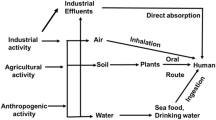Abstract
The effect of epoxide hydratase upon the mutagenicity of benzo(a)pyrene was investigated using two Salmonella typhimurium strains (TA 1537 and TA 98). These two bacterial strains were found to differ characteristically in their susceptibility to different mutagens biologically produced from benzo(a)pyrene providing a diagnostic tool to investigate which types of mutagenic metabolites were produced in various metabolic situations. The results showed that the pattern of mutagenic metabolites produced by microsomes from methylcholanthrene-treated mice was very different from that produced by microsomes from phenobarbital-treated or untreated mice. However in all cases at least two mutagenic metabolites were produced. Epoxide hydratase was very efficient at reducing the mutagenic effect when benzo(a)pyrene was activated by microsomes from untreated or phenobarbital-treated mice. However, when microsomes from methylcholanthrene-treated mice were used the effect of hydratase depended upon the benzo(a)pyrene concentration. At low concentrations the mutagenicity was increased by addition of epoxide hydratase and decreased by inhibition of the hydratase. At high concentrations the reverse was true. These findings indicate that when microsomes from untreated and phenobarbital-treated mice were used the main contributors to the mutagenicity were simple epoxides (or compounds arising non-enzymically from them). The activation of dihydrodiols must, however, contribute to a significant extent when microsomes from methylcholanthrene-treated mice were used. Thus the role of epoxide hydratase was determined by the monooxygenase form present in the microsomes in the activating system.
Zusammenfassung
Die Rolle der Epoxidhydratase wurde untersucht in bezug auf die Mutagenität von Benzo(a)pyren. Benzo(a)pyren wurde mit Lebermikrosomen aktiviert. Mutagene wurden festgestellt anhand der Reversion der his − Salmonella typhimurium-Stämme TA 1537 und TA 98. Die beiden Stämme wurden sehr unterschiedlich durch verschiedene mutagene Benzo(a)pyren-Metabolite rückmutiert. Es zeigte sich, daß das Muster der mutagenen Metabolite, die durch Mikrosomen von Methylcholanthren-behandelten Mäusen aus Benzo(a)pyren gebildet wurden, sehr verschieden war vom Muster bei Aktivierung durch Mikrosomen von Kontroll-oder von Phenobarbital-behandelten Mäusen. Jedoch trugen in allen drei Fällen wenigstens zwei verschiedene mutagene Metabolite signifikant zur Mutagenität bei. Epoxidhydratase reduzierte sehr effektiv die Mutagenität, wenn Benzo(a)pyren durch Mikrosomen von Kontroll-oder von Phenobarbital-behandelten Mäusen aktiviert wurde. Wenn jedoch Mikrosomen von Methylcholanthren-behandelten Tieren verwendet wurden, war der Effekt der Epoxidhydratase stark von der Benzo(a)pyren-Konzentration abhängig. Bei niedriger Konzentration erhöhte Zugabe von Epoxidhydratase und erniedrigten Epoxidhydratasehemmstoffe die Mutagenität. Bei hohen Konzentrationen wurde das Umgekehrte festgestellt.
Diese Befunde wurden dahingehend interpretiert, daß bei der Aktivierung mit Mikrosomen von unbehandelten und von Phenobarbital-induzierten Mäusen einfache Epoxide (oder Substanzen, die nicht-enzymatisch daraus gebildet wurden) hauptsächlich für die Mutagenität verantwortlich waren, daß dagegen Mutagene, die über Dihydrodiole gebildet wurden, bedeutend zur Mutagenität beitrugen, wenn Mikrosomen von Methylcholanthren-behandelten Mäusen verwendet wurden.
Die Rolle der Epoxidhydratase, ob aktivierend oder inaktivierend, wird demnach bestimmt durch die Form der Monooxygenase, die an der Aktivierung beteiligt ist.
Similar content being viewed by others
References
Ames, B. N., Durston, W. E., Yamaski, E., Lee, F. D.: Carcinogens are mutagens: A simple system combining liver homogenates for activation and bacteria for detection. Proc. nat. Acad. Sci. (Wash.) 70, 2281–2285 (1973)
Bentley, P., Oesch, F.: Purification of epoxide hydratase to apparent homogeneity. FEBS Lett. 59, 291–295 (1975)
Bentley, P., Schmassmann, H.-U., Sims, P., Oesch, F.: Epoxides derived from various polycyclic hydrocarbons as substrates of homogeneous and microsome-bound epoxide hydratase. Europ. J. Biochem. 69, 97–103 (1976)
Glatt, H. R., Oesch, F., Frigerio, A., Garattini, S.: Epoxides metabolically produced from some known carcinogens and from some clinically used drugs: Differences in mutagenicity. Int. J. Cancer 16, 787–797 (1975)
Glatt, H. R., Oesch, F.: Phenolic benzo(a)pyrene metabolites are mutagens. Mutation Res. 36, 379–384 (1976)
Holder, G. M., Yagi, H., Dansette, P., Jerina, D. M., Levin, W., Lu, A. Y. H., Conney, A. H.: Effects of inducers and epoxide hydratase on the metabolism of benzo(a)pyrene by liver microsomes and a reconstituted system: Analysis by high pressure liquid chromatography. Proc. nat. Acad. Sci. (Wash.) 71, 4356–4360 (1974)
Holder, G. M., Yagi, H., Jerina, D. M., Levin, W., Lu, A. Y. H., Conney, A. H.: Effect of substrate concentration and 3-methylcholanthrene pretreatment on hepatic metabolism by microsomes from rat and mice. Arch. Biochem. Biophys. 170, 557–566 (1975)
Huberman, E., Sachs, L., Yang, S. K., Gelboin, H. V.: Identification of mutagenic metabolites of benzo(a)pyrene in mammalian cells. Proc. nat. Acad. Sci. 73, 607–611 (1976)
Lu, A. Y. H., Levin, W., Vore, M., Conney, A. H., Thakker, D. R., Holder, G. M., Jerina, D. M.: Metabolism of benzo(a)pyrene by purified liver microsomal cytochrome P 448 and epoxide hydrase. In: Polynuclear aromatic hydrocarbons: Chemistry, metabolism and carcinogenesis (R. Freudenthal, P. Jones, eds.), pp. 115–125. New York: Raven Press 1976
Newbold, R. F., Brookes, P.: Exceptional mutagenicity of a benzo(a)pyrene diol epoxide in cultured mammalian cells. Nature (Lond.) 261, 52–54 (1976)
Oesch, F., Glatt, H. R.: Evaluation of the importance of enzymes involved in the control of mutagenic metabolites. In: Screening tests in chemical carcinogenesis (R. Montesano, H. Bartsch, L. Tomatis, eds.), pp. 255–295. Lyon: IARC Scientific Publications 1976
Oesch, F., Bentley, P., Glatt, H. R.: Prevention of benzo(a)pyrene-induced mutagenicity by homogeneous epoxide hydratase. Int. J. Cancer 18, 448–452 (1976)
Oesch, F., Bentley, P., Glatt, H. R.: Epoxide hydratase: Purification to apparent homogeneity as a specific probe for the relative importance of epoxides amongst other reactive metabolites. In: Active intermediates: Formation, toxicity and inactivation (J. R. Gillette, D. Jollow, J. J. Kocsis, H. Remmer, R. Snyder, H. Vainio, A. Hänninen, eds.), pp. 181–206. New York: Plenum Press 1977
Schmassmann, H.-U., Glatt, H. R., Oesch, F.: A rapid assay for epoxide hydratase with benzo(a)pyrene 4,5-(K-region-)oxide as substrate. Analyt. Biochem. 74, 94–104 (1976)
Selkirk, J. K., Croy, R. G., Roller, P. P., Gelboin, H. V.: High pressure liquid Chromatographic analysis of benzo(a)pyrene metabolism and covalent binding and the mechanism of action of 7,8-benzoflavone and 1,2-epoxy-3,3,3-trichloropropene. Cancer Res. 34, 3474–3480 (1974)
Sims, P., Grover, P. L., Swaisland, A., Pal, K., Hewer, A.: Metabolic activation of benzo(a)pyrene proceeds by a diol-epoxide. Nature (Lond.) 252, 326–328 (1974)
Thakker, D. R., Yagi, H., Lu, A. Y. H., Levin, W., Conney, A. H., Jerina, D. M.: Metabolism of benzo(a)pyrene: Conversion of (±)-trans-7,8-dihydroxy-7,8-dihydrobenzo(a)pyrene to highly mutagenic 7,8-diol-9,10-epoxides. Proc. nat. Acad. Sci. (Wash.) 73, 3381–3385 (1976)
Wood, A. W., Goode, R. L., Chang, R. L., Levin, W., Conney, A. H., Yagi, H., Dansette, P. M., Jerina, D. M.: Mutagenic and cytotoxic activity of benzo(a)pyrene 4,5-, 7,8-, and 9,10-oxides and the six corresponding phenols. Proc. nat. Acad. Sci. (Wash.) 72, 3176–3180 (1975)
Wood, A. W., Levin, W., Lu, A. Y. H., Yagi, H., Hernandez, O., Jerina, D. M., Conney, A. H.: Metabolism of benzo(a)pyrene and benzo(a)pyrene derivatives to mutagenic products by highly purified microsomal enzymes. J. biol. Chem. 251, 4882–4890 (1976)
Author information
Authors and Affiliations
Rights and permissions
About this article
Cite this article
Bentley, P., Oesch, F. & Glatt, H. Dual role of epoxide hydratase in both activation and inactivation of benzo(a)pyrene. Arch. Toxicol. 39, 65–75 (1977). https://doi.org/10.1007/BF00343276
Received:
Issue Date:
DOI: https://doi.org/10.1007/BF00343276




